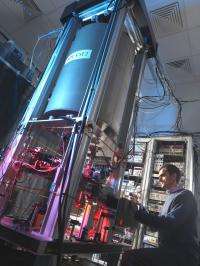Penn State physics professor helps keep world on schedule through work on the accuracy of clocks

How much is a fraction of a second worth? It could cost millions of dollars during a crash of the stock market, when panic selling causes investment values to plummet. A timing error of just one-tenth of a second could mean the loss of huge amounts of money. Ultra-precise timing also provides the high-security time stamps needed every day for large financial transactions. That’s why super-accurate clocks have become essential tools in the finance industry.
Super-accurate clocks also are an essential technology of GPS. If you want your GPS device to know where you and your destination are within several feet, your receiver needs to calculate where you are from the tiny time delays of the GPS satellite signals, which travel at the speed of light.
Kurt Gibble, a professor of physics at Penn State, is a member of the super-elite teams that build and then evaluate the accuracy of the world’s best clocks — those that are used by the United States and around the world as the “primary frequency standards” for telling time. Gibble said a goal of his research is “to advance physics to make the world’s best clocks even more accurate.”
Gibble and Ruoxin Li, a former graduate student in Gibble’s lab, recently collaborated with the national time-keeping organizations of the United Kingdom, France and Germany to prove the accuracy of several of the best clocks in the world. Working with a team at the National Physical Laboratory near London, they established one of the U.K.’s clocks as the world’s most accurate. Gibble’s most recent work further improves the accuracy of a clock in Paris, which might allow it to reclaim this title.
Besides building these clocks, Gibble also constructs mathematical models of the physics of how they work. Clock teams use a combination of Gibble’s models and physical measurements to adjust the components of a clock so that its tick rate is its most accurate — as close as it can get to exactly one second.
These elite clocks do not keep time with pendulums or quartz crystals, like our everyday clocks. Instead, they gauge the length of a second by measuring a property of individual cesium or rubidium atoms as they are tossed up and fall back down inside very unusual atomic fountains, like unimaginably small drops of water. One of the peskiest problems with the precision of these clocks happens when the atoms collide at the frigid temperatures needed for these ultra-precise time measurements.
In his lab at Penn State, Gibble has a cesium fountain clock and the first rubidium fountain clock ever built.
“We discovered that rubidium clocks can be much more accurate than cesium when the atoms are cooled to temperatures as low as a millionth of a degree above absolute zero,” he said.
As a result of this discovery, the first group of rubidium fountain clocks recently supplanted cesium clocks and hydrogen masers as the dominant contributors to the master clock of the U.S. Naval Observatory, which sends time updates to GPS satellites.
Gibble recently joined a French team that is building an atomic clock to operate in space.
“My group has made a number of contributions to the design and architecture of space clocks, which have the potential for unprecedented accuracy,” Gibble said. “Our models give an improved understanding of the three biggest physical factors that degrade the accuracy of these clocks: Doppler shifts, a lensing of the atoms by the microwaves that probe the atoms, and the ultracold collisions.”
Here on Earth, Gibble’s work is helping to improve the accuracy of Coordinated Universal Time, which is computed monthly as an average of all the times reported by national clocks, including those whose accuracy Gibble has helped to improve. Coordinated Universal Time is the official international time scale. It is used worldwide, including for global communications systems and financial transactions, and Gibble’s work is helping to make it ever more accurate.
More information: This article, written by Barbara Kennedy and featuring the work of Penn State physicist Kurt Gibble, originally appeared in the Centre Daily Times (CDT) on 8 July 2012 in the bimonthly "Focus on Research" column, which highlights different research projects being conducted at Penn State.
Provided by Pennsylvania State University
















